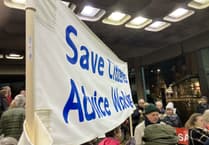THE AUSTERE Inkerman Barracks at Knaphill were home to a number of British Army regiments and units over a period of 69 years.
The buildings were constructed as a prison for invalid male convicts and opened in 1859.
A second prison, for female convicts, opened in 1869.
Covering 63 acres with a wall 18ft high, the two prisons combined held an average of 650 inmates at any one time.
Changes to Britain’s penal system saw the closure of the male prison in March, 1889.
It was handed over to the War Office, although it seems the female prison did not close until November, 1895.
The prison buildings were converted to house two infantry battalions, and in 1895 became Inkerman Barracks.
The barracks were named after the Battle of Inkerman, which took place during the Crimean War of 1853-56.
The first regiment to be quartered in the barracks was the 2nd Battalion of the Queen’s Royal (West Surrey) Regiment.
The next year, the barracks were occupied by the East Surrey Regiment, followed by the Royal Northern Reserves Regiment (1900), the Royal Berkshire Regiment (1902), the Royal Scots (1904), the King’s Liverpool Regiment (1906) and the East Lancashire Regiment (1908).
Peeps reader Trevor Howard owns the fabulous picture postcard seen here of the East Lancashire Regiment in Goldsworth Road, Woking.
Trevor said the soldiers were returning to Inkerman Barracks from the coronation in London of George V on June 22, 1911.
They had taken part in a parade, as part of the coronation, with many other regiments.
The photo is looking towards Victoria Arch.
Trevor said: “On the left edge of the picture, the awning advertises Frank Bayliss’ greengrocer’s shop, although he had retired two years earlier.
“From the left, the first semi-detached pair was Thornton Villas. The next three semi-detached pairs were Plevna Villas, named after the battle of Plevna – now Pleven, Bulgaria.
“The siege of Plevna was a major battle of the Russo-Turkish War of 1877-78, fought by the joint army of the Russian Empire and Kingdom of Romania against the Ottoman Empire.
“The siege began in July, 1877 and did not end until December of the same year.
“Beyond Plevna were the pair of Emerson Villas and then the baptist chapel, with the, presumed, bell tower on top. Beyond the chapel were the pair of Farmville Villas.
“All of the villas were built as residential houses in the 1870s and later converted to retail use.
“The open space on the right of the view is where the Aldershot & District bus garage was built 20 years later.”
During the First World War, several regiments may have passed through Inkerman Barracks, including troops from South Africa.
The barracks were also used as a military war hospital during this time.
In 1924, the Royal West Kent Regiment (Queen’s Own) made its home at Inkerman Barracks.
The regiment’s history reveals the 2nd Battalion had retuned to Britain in 1921, having served in India and Mesopotamia.
It was stationed at various British garrisons until 1937, when it went to Palestine to help with the suppression of the Arab revolt. In 1939 it was posted to Malta.
The Royal Warwickshire Regiment replaced the West Kents at Inkerman Barracks in 1927.
Later came the Royal Welch Fusiliers (1935), the Durham Light Infantry (1937) and, in 1947, the Royal Military Police (RMP).
The RMP moved there from nearby Mytchett and used the barracks as a training depot.
At any one time there could be more than 400 recruits passing through on their initial three-month training course.
The RMP then moved to new barracks that opened in Chichester during the mid-1960s.
While the site at Knaphill lay derelict, on May 29, 1964 a blaze destroyed several wooden (spider) huts within the barracks’ site.
A combination of their wooden construction and the creosote painted on them made them highly inflammable.
The News & Mail report at the time did not mention any possible cause of the fire.
The dates listed on this page regarding the regiments that passed through the barracks were included in a story published in the News & Mail on February 26, 1960.
This reported the official announcement, under the British Army’s eight-year development for its Aldershot District, that Inkerman Barracks would close and the site would be sold.




